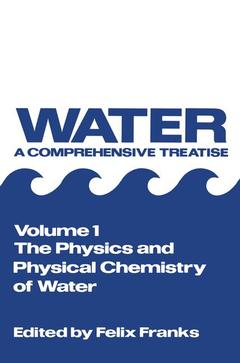to arrive at some temporary consensus model or models; and to present reliable physical data pertaining to water under a range of conditions, i.e., "Dorsey revisited," albeit on a less ambitious scale. I should like to acknowledge a debt of gratitude to several of my col leagues, to Prof. D. J. G. Ives and Prof. Robert L. Kay for valuable guidance and active encouragement, to the contributors to this volume for their willing cooperation, and to my wife and daughters for the understanding shown to a husband and father who hid in his study for many an evening. My very special thanks go to Mrs. Joyce Johnson, who did all the cor respondence and much of the arduous editorial work with her usual cheerful efficiency. F. FRANKS Biophysics Division Unilever Research Laboratory ColworthjWelwyn Colworth House, Sharnbrook, Bedford March 1972 Contents Chapter 1 Introduction-Water, the Unique Chemical F. Franks I. lntroduction ........................................ . 2. The Occurrence and Distribution of Water on the Earth 2 3. Water and Life ...................................... 4 4. The Scientific Study of Water-A Short History ........ 8 5. The Place of Water among Liquids . . . . . . . . . . . . . . . 13 . . . . . Chapter 2 The Water Moleeule C. W. Kern and M. Karplus 1. Introduction. . . . . . . . . . . . . . . . . . . . . . . . . . . . . . . 21 . . . . . . . . . . 2. Principles of Structure and Spectra: The Born-Oppenheimer Separation . . . . . . . . . . . . . . . . . . . . . . . . . . . . . . . 22 . . . . . . . . . . . . 3. The Electronic Motion ............................... 26 3.1. The Ground Electronic State of Water ............ 31 3.2. The Excited Electronic States of Water ........... 50 4. The Nuclear Motion ................................. 52 5. External-Field Effects ................................. 70 5.1. Perturbed Hartree-Fock Method . . . . . . . . . . . . . . . 74 . . .




